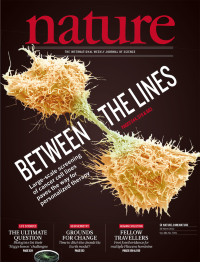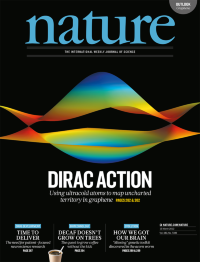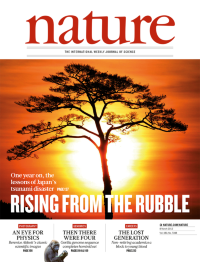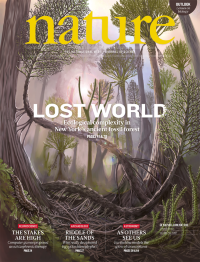Volume 483
-
No. 7391 29 March 2012
Cancer cell lines are widely used as preclinical models to gain mechanistic and therapeutic insight. Two manuscripts in this issue describe the large-scale genetic and pharmacological characterization of human cancer cell lines. Each group characterized collections of several-hundred cell lines using different platforms and analytical methods. Their results are complementary, and confirm that many human cell lines capture the genomic diversity of their respective cancers. Initial findings include the identification of a number of potential markers of drug sensitivity and resistance. For example, Garnett et al. report an association between EWSFLI1 gene translocations, frequently found in Ewings sarcoma, and sensitivity to PARP inhibitors, a class of drug currently in clinical trials for other cancer types. Barretina et al. report a possible association between SLFN11 expression and sensitivity to topoisomerase inhibitors. On the cover, dividing fibrosarcoma cells. Cover credit: Steve Gschmeissner/SPL/Corbis
-
No. 7390 22 March 2012
The cover shows a detail from Through the Looking Glass, a large-scale glass artwork by TED Fellow Kate Nichols, which uses silver nanoparticles as 'paint'. The colours arise from oscillations of electrons in the metal particles, called localized surface plasmon resonances. The plasmonic properties of these particles make them attractive for a variety of imaging, sensing and renewable-energy technologies. But it is the particles less than 10 nanometres in diameter that may be most relevant to many natural and engineered systems. As particles approach the quantum regime, our knowledge of how their plasmonic properties change becomes rather hazy. Jonathan Scholl and colleagues investigate the plasmonic properties of individual silver nanoparticles with dimensions in the quantum size regime. Using electron microscopy and spectroscopy, they correlate a particle's plasmon resonance with its size and geometry for diameters ranging from 20 nm to less than 2 nm. The results demonstrate the quantum-mechanical nature of small metallic nanospheres, with direct applications to catalytically active and biologically relevant nanoparticles. Cover credit: Kate Nichols, Alivisatos Lab, Univ. California, Berkeley, www.katenicholsstudio.com/ Photo: Donald Felton.
-
No. 7389 15 March 2012
The electronic structure of certain solids causes them to exhibit Dirac points, which lie at the heart of many fascinating phenomena in condensed-matter physics. In graphene, for example, they cause electrons to act as massless Dirac fermions, able to travel at the speed of light. Two very different methods for controlling the properties of Dirac fermions are presented in this issue of Nature. In conventional solids, the electronic structure of the material cannot be varied, so it is difficult to see how the properties of Dirac fermions could be controlled. To avoid this constraint, Tarruell et al. create a tunable system of ultracold quantum gases within an adjustable honeycomb optical lattice. This model simulates condensed-matter physics, with atoms in the role of electrons. The Dirac points can be moved and merged to explore the physics of exotic materials such as topological insulators and graphene. On the cover, the band structure of artificial graphene with intersections at two Dirac points. Gomes et al. describe a more direct approach, creating an artificial form of molecular graphene by arranging carbon monoxide molecules, with atomic precision, in a honeycomb pattern on top of a two-dimensional electron system. Lattice parameters are adjustable, allowing the study of the properties of Dirac electrons and even the production of 'pseudo' electric and magnetic fields. This work highlights an innovative technique for constructing artificial materials with molecular assembly, including designer Dirac materials harbouring new ground states.Cover: Thomas Uehlinger / Inset: Shutterstock
Nature Outlook
-
No. 7388 8 March 2012
It is almost a year since the Fukushima Daiichi nuclear power plant was crippled by earthquake and tsunami damage. In this special issue, we look at how Japan has set about rebuilding the communities that suffered most from the natural and nuclear disasters. In Japan and elsewhere, the Fukushima experience has caused much rethinking of the economics of nuclear power, and of the state of seismic and tsunami early-warning systems. On the cover, Rikuzentakatas tree of hope, a salt-damaged pine tree that survived the tsunami, pictured at sunrise on 1 January 2012. Credit: Tsuyoshi Matsumoto/Yomiuri Shimbun/AP
-
No. 7387 1 March 2012
The worlds oldest fossil forest, famously the subject of an innovative exhibit at New York State Museum in the 1920s, was discovered during stone quarrying for the Gilboa dam and reservoir in Schoharie County, New York. Palaeontologist Winifred Goldring undertook the scientific description and illustration of in-place Eospermatopteris stumps and speculated on their significance. Her original publications continue to influence views on the origin of forest ecosystems, including the roles they may have had in global dynamics and extinction. The quarry was backfilled and remained inaccessible for 90 years, but in 2010 Stein et al. located the original ancient forest soil surface and mapped part of the site. Instead of one kind of tree, they found three, with evidence of spacing and biotic interactions between surprisingly different plant forms. These discoveries should have a major impact on interpreting further fragmentary fossil evidence of these early forests. On the cover, a reconstruction by Victor Leshyk.
Nature Outlook





